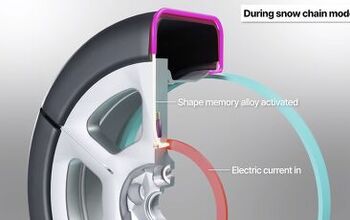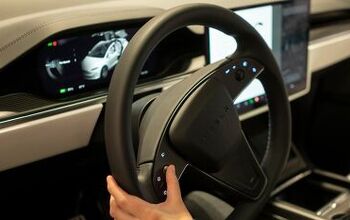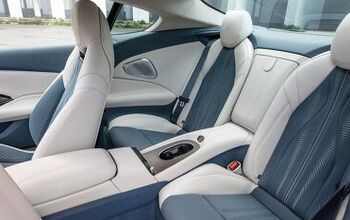If Robots Can Build Our Cars, Why Don't They Service Them?

Robots may be able to assemble your car, but they aren’t going to be servicing it anytime soon. Automation has made many industrial occupations irrelevant over the last few decades. Machines have even begun entering the fast-food industry and proven themselves adept line cooks. So then why aren’t they changing your oil?
The technology is available but implementing it is too damned expensive and slow. No machine yet qualifies as a “full-service” device, so centers would have to purchase multiple rigs and keep someone on staff to operate them — not exactly cost-effective. However, as those machines come down in price and gain in number, we’ll begin seeing them put into use more and more. Eventually, you’ll be returning to the servicing department to complain about a robot ruining your car instead of an inexperienced mechanic. But when?
According to a recent study from the McKinsey Global Institute, roughly half of today’s labor-intensive jobs would be occupied by machines by mid-century. Although, that could come a decade sooner or later — depending upon economic conditions, how quickly the necessary technology is ready, and how fast businesses adopt it.
“The timing might not be as near term as some people might imagine,” Mehdi Miremadi, co-author of the report, explained to Automotive News.
Miremadi examined the servicing tasks dealerships are responsible for and found that between 30 and 50 percent of the work currently being performed by flesh could be done by steel in the future. “Technology has to be cost competitive with human labor, and right now technology in its current form is simply too cost prohibitive,” he said. “Also remember the economy has to make room for the new jobs and skill sets that will be necessary to operate and program these machines.”
Hunter Engineering has developed several automated systems for service centers, including an automatic tire mounting machine that costs in excess of $30,000.
“Eight, ten years ago, when we were designing the Revolution machine, we were looking at a tech having to use a pry bar to physically remove the tire,” explained Kaleb Silver, senior product manager at Hunter. “The technician did a lot of the work there and made a lot of the movements. The machine reduced the risk involved in changing that tire.”
At present, most automated tire mounting devices cost more than many of the cars they would be servicing and still require some level of human involvement to function properly. They also aren’t any faster than someone who really knows what they’re doing with a set of hand tools — making them less desirable in certain instances. Hunter says the machines they decide to produce depends largely on what kind of return on investment a business purchasing them could expect.
“An oil-change robot would have been twice as valuable 10 years ago as it is today, because 10 years ago you changed oil twice as often,” Silver said.
In Asia, partially automated oil change stations are cropping up in parking lots. Roughly the size and shape of vending machines, the devices allow scooter-owners to vacuum out dirty oil and replace it in one easy step. It doesn’t replace the filter but provides a physical example of where things are heading.
Collaborative work between humans and machines will likely remain the norm for some time. We already see this on the assembly line. Robotics are wonderful at repetitive tasks but need someone to provide oversight and fill in where you can standardize the experience.
“Jobs that are dirty, dull or dangerous; in the industrial realm, that’s where we sell robots,” says Claude Dinsmoor, general manager for general industries and automotive segment at industrial robot manufacturer Fanuc Robotics America. “And when we look at a service bay, it’s not much different than a general assembly area of [an auto assembly plant], although it may not be as clean. But I’m seeing a lot of the same tools.”
Dinsmoor says he anticipates task-specific robots that would work alongside technicians rather than replace them.
“You still have to have the people around. That’s going to be the key driver in the service area,” Dinsmoor said. “If you put the robot in front of the car or the wheel, it can find the tire and the lug nuts easy enough. Fluid fill becomes an opportunity [for automation]. Those tasks don’t take much time for a person, but if you could automate those tasks, that frees up time for the person to do higher-level work.
“I think they’re going to look different, and they’re going to be built with a purpose in mind. It’s not going to look like C-3PO. It’s going to look more like R2-D2 — something that’s purpose-driven,” Dinsmoor says. “After 35 years in the robotics industry, we learn every day how sophisticated people really are.”
[Image: Yonkers Honda/ Flickr ( CC BY-SA 2.0)]

A staunch consumer advocate tracking industry trends and regulation. Before joining TTAC, Matt spent a decade working for marketing and research firms based in NYC. Clients included several of the world’s largest automakers, global tire brands, and aftermarket part suppliers. Dissatisfied with the corporate world and resentful of having to wear suits everyday, he pivoted to writing about cars. Since then, that man has become an ardent supporter of the right-to-repair movement, been interviewed on the auto industry by national radio broadcasts, driven more rental cars than anyone ever should, participated in amateur rallying events, and received the requisite minimum training as sanctioned by the SCCA. Handy with a wrench, Matt grew up surrounded by Detroit auto workers and managed to get a pizza delivery job before he was legally eligible. He later found himself driving box trucks through Manhattan, guaranteeing future sympathy for actual truckers. He continues to conduct research pertaining to the automotive sector as an independent contractor and has since moved back to his native Michigan, closer to where the cars are born. A contrarian, Matt claims to prefer understeer — stating that front and all-wheel drive vehicles cater best to his driving style.
More by Matt Posky
Latest Car Reviews
Read moreLatest Product Reviews
Read moreRecent Comments
- Turbo Is Black Magic My wife had one of these back in 06, did a ton of work to it… supercharger, full exhaust, full suspension.. it was a blast to drive even though it was still hilariously slow. Great for drive in nights, open the hatch fold the seats flat and just relax.Also this thing is a great example of how far we have come in crash safety even since just 2005… go look at these old crash tests now and I cringe at what a modern electric tank would do to this thing.
- MaintenanceCosts Whenever the topic of the xB comes up…Me: "The style is fun. The combination of the box shape and the aggressive detailing is very JDM."Wife: "Those are ghetto."Me: "They're smaller than a Corolla outside and have the space of a RAV4 inside."Wife: "Those are ghetto."Me: "They're kind of fun to drive with a stick."Wife: "Those are ghetto."It's one of a few cars (including its fellow box, the Ford Flex) on which we will just never see eye to eye.
- Oberkanone The alternative is a more expensive SUV. Yes, it will be missed.
- Ajla I did like this one.
- Zerofoo No, I won't miss this Chevrolet Malibu. It's a completely forgettable car. Who in their right mind would choose this over a V8 powered charger at the rental counter? Even the V6 charger is a far better drive.


































Comments
Join the conversation
Yep, vehicles would need mods to facilitate 'robotic' servicing. I don't see that happening soon as the cost per vehicle would give the manufacturer's accounting dept (both human and computer) a heart attack. We have had automated car washes for some time. Not that complicated to add in oil change, but as others have noted, vehicles would need to be standardized/modified. Probbly not going to happen due to cost. With the way the system works there will be plenty of people that will strip your drain plug for $11 per hour. There are plenty of other areas for 'robots' to take over. See Amazon's proposal for multi-copters (they are not "drones") delivering your package.
Another example of lazy journalism on a supposedly "car"-centric blog. No-one who ever turned a wrench and tried to diagnose a problem will buy into these wet dreams of self-proclaimed "analysts". Who in their 20-something years of ignorant existence barely learned the skill of wiping there own arrears. Same applies to never-ending topics about electric/autonomous 18-wheelers, ships, brick-laying, etc. Where's the down-vote button?..